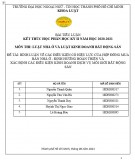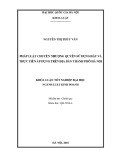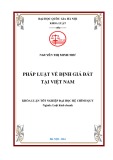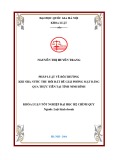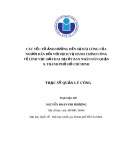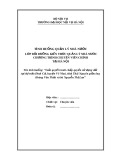
MINISTRY OF EDUCATION AND TRAINING
MINISTRY OF CONSTRUCTION
HANOI ARCHITECTURAL UNIVERSITY
---------------------
LE THI AI THO
MANAGEMENT OF SPACE, ARCHITECTURE,
LANDSCAPE OF INDUSTRIAL ZONE IN HANOI CITY
SPECIALIZATION: URBAN AND CONSTRUCTION MANAGEMENT
CODE: 62.58.01.06
DOCTORAL THESIS SUMMARY
Hanoi-2020

The thesis is completed at Hanoi Architectural University
Academic supervisors: 1. Assoc.Prof. Dr. Arch Nguyen Tuan Anh
2. Dr. Arch. Nguyen Duc Dzung
Reviewer 1:
Reviewer 2:
Reviewer 3
This thesis was presented at the PhD Thesis Committee
At Hanoi Architectural University
At............on................2020
The thesis can be found at:
1. The National Library
2. The library of Hanoi Architectual University

INTRODUCTION
1. Rationale
Hanoi is the heart of the Vietnam, the center of politics, culture, science and
technology, Hanoi has invested in construction and development of industrial zones
(IZs) quickly, attracting many investment projects in and abroad investors. As of
2019 Hanoi, there are18 IZs have been authorized by the Prime Minister to establish
and approve the planning portfolio with a total area of nearly 5.200ha and have
brough many benefits to the development of Hanoi.
However, IZs contributions are not commensurate with the goal of the proposal,
in fact there are many problems in the development process such as the use of
industrial land is not yet effective, the status of using land in wrong way is still
happening. The architecture is built with 1 floor, spreading almost in area,
monotonous images, simple materials, poor aesthetic and non-specific space. The
landscape is not invested reasonably, lack of green areas, sub-scene and public
utilities to serve the workers. One of the causes of the above problems that is the
management of space, architecture, landscape of IZs in HaNoi has many problems
as follows: The management of the organization implementing the planning,
management of land resource utilization has not good, do not realy undestand about
the long-term goal of the use of urban space, organization of landscape and
architecture in IZs in the city; comfort conditions and facilities for workers, green
environment has not been care with the point of economic growth benefit must be
parallel with environmental protection, landscaping and conditions for employees;
Legal documents, regulations on space, architecture, landscape for IZs have been
missing. The State management structure is not strong and flexible enough.
Advances in Science and technology are rarely applied. Beside that lack of sharing
of responsibilities and rights of stakeholders in the development of IZs including the
Government-Investor-Community- Consultants.
Currently the world has been undergoing a phase against the epidemic Covid
19 along with it is the pull of many changes in economic development and the global
production chain. Create a trend to move the production chain into Vietnam
especially in the big city such as Hanoi or Ho Chi Minh, where is consider favorable,
safe, attractive area and full of functions for the post-Covid of foreign investors.
Therefore, it is necessary to have timely studies to ensure the effective state
management of IZs in general and space, architecture, landscape in IZs in Hanoi in
particular. From the perception that this is a scientific task of importance in the
management of urban Development, the selection of the research topic "
Management of space, architecture, landscape in industrial zones in Hanoi City"
is necessary with the purpose that the sustainable development for Hanoi Capital.

2
2. Purposes of research
The study proposed the solutions to improve effectiveness in management of
space, architecture, landscape in IZs in Hanoi with the aim of increasing the
efficiency of land use, beautiful and uniform in the construction of buildings, good
environment and comfortable facilities for IZs, towards Hanoi is the city of Green,
Cultural, Civilization, Modern and Sustainable.
3. Subject and scope of research:
- Subject of research: Subject of the study is state management of space,
architecture, landscape IZs in Hanoi
- Scope of research
+ Space/location: Industrial zone in Hanoi city.
+ Time: The thesis carries out the research in the period to 2030, with the
vision of 2050 according to the general planning of Hanoi Construction Master.
4. Research Methodology
The thesis uses research methodologies including: Data collection and Site
survey; Sociological investigation; Statistic and Comparision; Expert consultation;
Forecasting; Interview.
5. Scientific and practical significance of the topic
- Scientific significance
+ Overview of theory and practical about space, architecture, landscape in IZs
and management of space, architecture, landscape in IZs in Hanoi city.
+ The thesis will help completing and developing management science content
about space, architecture, landscape in IZs in general and management of space,
architecture, landscape in IZs in Hanoi city in particular.
+ The study results can be used as reference materials in scientific research, and
It is the basic condition to correct the legal documents on management of space,
architecture, landscape in IZs.
- Practical significance
Identify main issues on management of space, architecture, landscape in IZs in
Hanoi; Completing on management regulations of space, architecture, landscape in
Vietnam and Hanoi; Contributing to establish the management regulations,
construction planning, renovation in IZs current and in the future.
6. New contributions of the thesis
(1.) Overview and assessing the current situation of the space, architecture,
landscape of the industrial zones and the management of the space, architecture and
landscape of the industrial zones in Vietnam and Hanoi capital.

3
(2.) Give the general calculation and at the same time about 03 objects are space,
architecture, landscape in IZs. That is give the suitable floors for building and
adjustment index in construction building and landscape area to manage effectively
of space in IZs, especially in Hanoi city.
(3.) Proposed management criteria and solutions to manage the space,
architecture, landscape in IZs in Hanoi.
7) Concepts and glossary interpretation in the thesis
- Space of IZs: is limited by the three dimensions of the zone covering the surface
of the land; the space is empty and the underground.
- Architecture of IZs: These objects occupy the space that has been built according
to the requirements of the production process such as public buildings, production
buildings, warehouses, auxiliary houses, engine areas, underground works, etc.
- Landscape of IZs: The rest of the space is composed of natural elements such as
natural areas, lakes, water areas... or created and built by humans in order to have
the comfortable conditions and good areas for workers.
- Managing of space, architecture, landscape in IZs is the process of impact of state
management agencies on the space, architecture, landscape in IZs to achieve unity,
harmony and efficiency
8) Thesis Structure:
The thesis consists of 3 parts: Introduction; Main content; Conclusions and
Recommendation. In particular, the content consists of 3 chapters:
- Chapter 1: Overview of space, architecture, landscape management in industrial
zone in Hanoi. (50 pages)
- Chapter 2: The scientific basis of space, architecture, landscape management in
industrial zone in Hanoi. (46 pages)
- Chapter 3: Solutions for space, architecture, landscape management in industrial
zone in Hanoi. (48 pages)
CONTENT
CHAPTER 1: OVERVIEW OF SPACE, ARCHITECTURE, LANDSCAPE
MANAGEMENT OF INDUSTRIAL ZONES IN HANOI
1.1. Development and management of IZs in the world and Vietnam
The thesis has overviewed of the situation, the development stages as well as the
development model of IZs in the world and Vietnam. Especially the the management
issues of IZs in domestic and abroad such as planning management, construction and
environment management; Organization of management structure; the policy ..etc..
1.2. Situation of space, architecture, landscape of IZs in Hanoi
- The situation of developing IZs in Hanoi: There are 18 IZs in city in which 08




